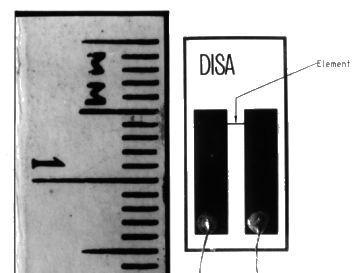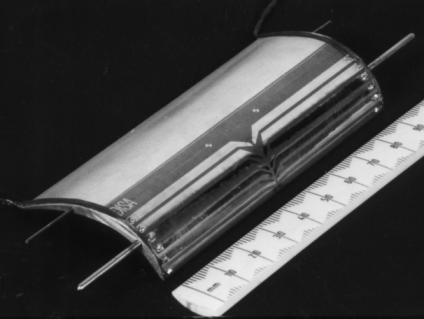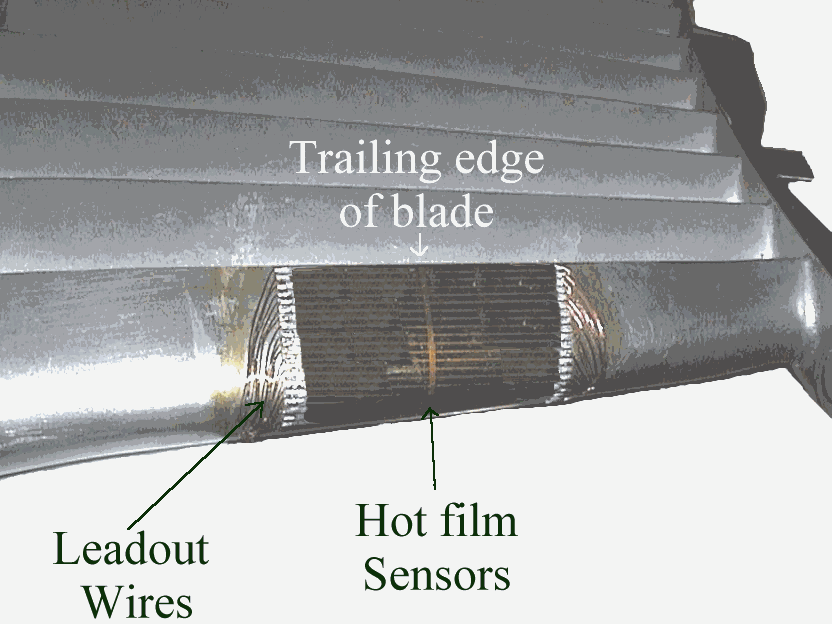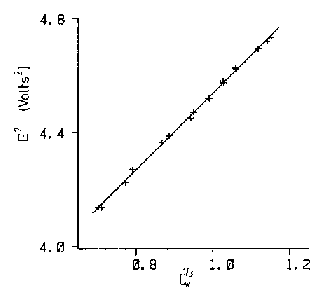Because of the uncertainty associated with the boundary layer predictions, the turbine designer is still dependent upon data obtained by experiment. Ideally, this data would include a complete survey of blade surface boundary layers, but this is difficult to obtain in cascades of conventional size and the cost of such an investigation is often high. In high-speed turbomachines, it is impossible to obtain such data. Fortunately, however, significant improvements in blade performance can often be made once the location, if any, of boundary layer transition, separation and re-attachment has been determined. Flush-mounted anemometry is a specialised application of thermal anemometry that has found favour in turbomachinery research by virtue of its simplicity. It fulfils the requirement for a simple, robust and cost effective technique that will provide this information.

A single sensor glue on hot film
The measurement of wall shear stress using an electrically heated element set into the surface is a well established technique that relies upon the similarity between the velocity profile adjacent to the wall and the temperature profile of the thermal boundary layer that is generated by the element.
The sensing elements are most often produced by the deposition, usually by evaporation, onto either a ceramic insert or a thin (60 mm) and flexible plastic sheet. The flexibility of the plastic substrate is utilised when fitting sensors to existing hardware because it enables the blade profile to be retained after the fitting of the gauges.

Sensor array fitted to leading edge of a low pressure turbine cascade airfoil
The above picture shows a typical array of sensors. The gauges may be fitted to the blades by gluing them, using an epoxy resin, into a pocket that has been machined out of the blade surface. The picture below shows another array fitted to a Rolls Royce low pressure turbine blade. In this case, the array is fitted to the blade using an epoxy adhesive. On large (chord > 150 mm), low speed blades, the array may be fixed to the blade using self adhesive tape so that it possible to remove the sensor for calibration.

Sensor array fitted to a low pressure turbine stator
The relationship between the rate of heat transfer from a hot-film, that is proportional to the square of the anemometer bridge voltage, and wall shear stress for a thin-film gauge is given by
E2 - A2=ktw1/3
where the constant, A is almost equal to the output voltage of the anemometer at zero-flow (=E0).

Typical calibration for a hot film sensor
The constants A and k in equation may be determined, for the operating range of the sensor, by calibrating the hot-film against a Preston Tube in say the turbulent boundary layer of a flat plate.
It should be noted that errors of up to 10 percent can be expected if a calibration obtained from measurements in a turbulent boundary layer is used to determine the value of shear stress in a laminar boundary layer. This is caused by the different nature of laminar and turbulent flows close to the wall. It should also be noted that the dynamic sensitivity of a hot-film can be less than that suggested by the static calibration. This is due to the thermal feedback via the substrate that is upstream of the heated element.
In many investigations, surface mounted hot-films are required to provide only qualitative or semi-quantitative data about the state of the boundary layers. This is because the effort required to calibrate these gauges and to compensate for the large changes in output that occur as ambient conditions alter cannot be justified given the requirements of the experiment. Fortunately, however, the rate of heat lost to the substrate (denoted by A2) is approximately equal to the total rate (E02) measured under zero-flow conditions and the net heat transfer rate (E2 - E02) can be assumed to be proportional to the cube root of the wall shear stress. The effects of the small differences in sensor area, resistance, etc., upon the calibrations of the various sensors are lessened by reducing the data to the form of (E2 - E02)/E02 Implicit in this method of data reduction is the assumption that the rates of heat transfer to the air and the substrate are similar functions of the same variables. Research in other groups has shown that this is usually the case.
The group has also developed a Miniature Hot Film Anemometer for use in confined spaces such as those inside the rotating hub of a turbomachine
Home | Current Research | Research Opportunities
Publications | Staff and Students
Research Facilities | Travel Information | Contact Information | Links